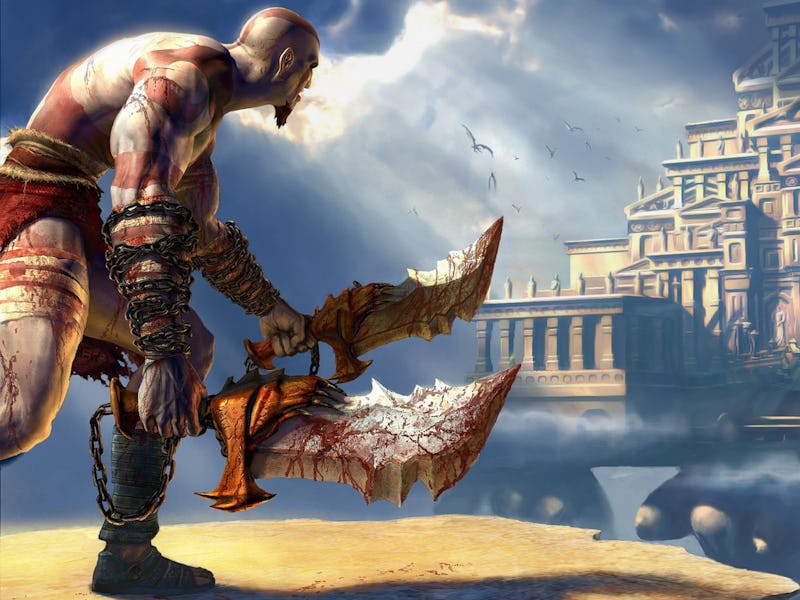A forgotten PSP game may solve a strange God of War plot hole
A compelling answer to a mysterious question.

Even with the reinvention of Kratos as a sad dad in God of War (2018), and its sequel Ragnarok, the Blades of Chaos remain a constant iconic symbol of character. Yet what is often identified as his signature blades are actually a series of three similar sets of blades with their own complicated history. A new fan theory digs into the power within the blades and the source of their fiery fury, solving a long mystery of the series in the process.
Too many blades — The new theory was first shared on Reddit by user MidKnight_Corsair who was interested in a potential lore inconsistency about the iconic blades.
Over the course of the original Greek-centered narrative that spanned the main trilogy and several side stories on PSP the blades change color many times. This is linked to which pair of blades Kratos wields and where they draw their power from.
The Blades of Athena have a never explained plot hole.
Though generally referred to as the Blades of Chaos, Kratos actually wields more than just one set of blades. The Blades of Chaos are the first and most famous, forged by Ares in the depths of the underworld to be wielded by a worthy servant of the god of war. That would be Kratos. Forged in the fiery underworld the Blades of Chaos had the ability to ignite a hellish fire.
At the end of God of War 1, the Blades of Chaos are thought to be lost and as Kratos ascends to godhood, he receives the Blades of Athena. These are essentially the same except for the cosmetic difference of glowing a golden blue hue rather than the red of the Blades of Chaos. This is due to the new source of power for the Blades of Athena, which come from the Goddess of Wisdom rather than the depths of Hades.
These are the blades Kratos wields till the end of God of War 3, at which point they are drained of power and restored by Athena as the newly minted Blades of Exile. The time-line seems fairly straightforward except for one inconsistency during the events of God of War 2, “Once you've reached the max level of the Blades of Athena, its original appearance is restored,” writes MidKnight_Corsair, “and once again glows a bright... red. Huh.”
Thera imbues the blades with power that is separate from the gifts granted by the gods.
The fire titan — As mentioned, the Blades of Athena originally glowed golden blue. So, what leads them to glow red once they are fully powered up and restored after Kratos is stripped of his godhood? MidKnight_Corsair believes the PSP game God of War: Ghost of Sparta holds the answer.
Ghost of Sparta takes place in between the events of God of War 1 and 2, during the tenure of Kratos as the god of war. He sets out to find answers on his past and the role the Greek pantheon has had in his life. At one point Kratos meets the imprisoned titan Thera. Upon freeing the titan from her prison, Thera imbues the Blades of Athena with her own power, Thera’s Bane. Using Thera’s Bane would make the Blades of Athena black and red, with a deep red fire.
In the opening of God of War 2, Kratos is stripped of his godhood and the power of the Blades of Athena is drained. But only the power imbued by Athena and the pantheon is drained, leaving Thera’s Bane to be the dominant force within the blades once you max them out by the end of the game. Thus, explaining why for the rest of the series the blades carry a red aura.
As for how this connects to the Norse saga of Kratos, well it doesn’t. The Blades of Athena, later the Blades of Exile, are abandoned by Kratos at the end of God of War 3. The blades that appear in God of War (2018) and Ragnarok are the Blades of Chaos, his original set of blades, as he explains they keep returning to him no matter how many times he has attempted to destroy or otherwise get rid of them. But MidKnight_Corsair’s theory helps explain a previously unexplained part of the lore in a satisfying way that ties together lesser talked-about entries in the long-running series. Who knows, maybe the Blades of Exile will show up in the future, no one really knows what befell them.
God of War Ragnarok is out now for PS4 and PS5.
This article was originally published on